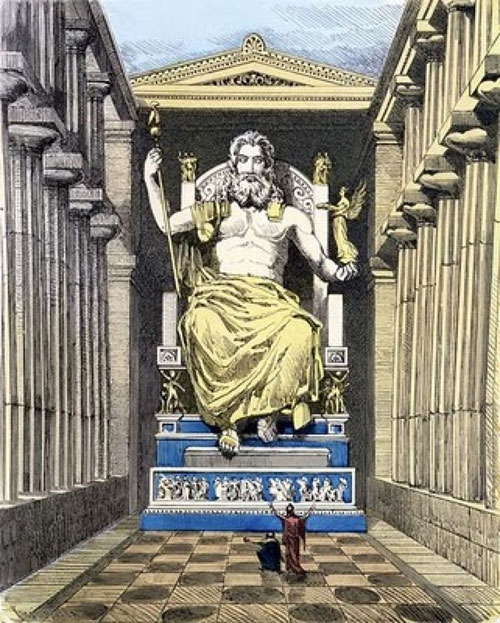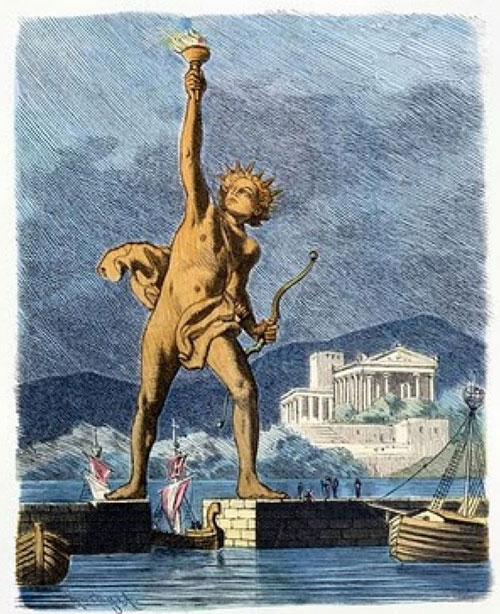Compare 7 world wonders in ancient and modern times
Many of us know the list of 7 wonders of the ancient and modern world but not everyone understands them. Learn about the history of these 14 wonders and answer the question: why are they voted as world wonders?
Seven wonders of the ancient world
1. Statue of Zeus in Olympia (Greece)

The giant golden statue of the king of Greek gods was built to honor the first Olympic exams, originating in the ancient city of Olympia . The statue was completed around 432 BC, depicting the god sitting on a jade wooden throne encrusted inside a temple overlooking the city.
Statue 12m high, 7m wide, one hand holding a scepter decorated with an eagle symbolizing the supreme power of the king in the gods, the other hand holding a statue of Victory with a wing symbolizing victory in the Wonders The Olympics are made of ivory and precious metals. Godhead Zeus wears olive wreath. The throne is made of cedar wood and ivory. The god foot rests on a large chair.
Many historians believe that the statue of Zeus was transferred to Constantinople (now Istanbul) in Turkey but later burned in fire.
2. Statue of the Sun of Rhodes (Greece)

In contrast to the pyramids, the Statue of the Sun of Rhodes has the shortest lifetime of the seven wonders of the ancient world. Completed in 282 BC after 12 years of construction, this giant statue was collapsed by an earthquake that occurred 56 years later.
The statue of the Sun God is 33m high and is the highest known statue of the ancient world, made of stone and iron with a bronze appearance. The statue of the Sun God in Rhodes is a giant bronze statue of the sun god Helios - the protector god of Rhodes - that helped the city escape the siege of the Macedonian king Demetrios I Poliorcetes in 305 BC original.
3. Great Giza pyramid (Egypt)

Around 2560 BC, the Egyptian Pharaoh Khufu built his mausoleum of three main pyramids and small satellite pyramids in Giza, bordering the borders of Cairo today. The tilt of the sides of the Pyramid is about 51.5 degrees. The height of the inclined surface is 195 m. The four sides of the Pyramid look at four directions: north, south, east and west.
This giant stone structure is 146m high with a surface area of about 1,300m2. The Great Giza pyramid is considered to be the planet's tallest man-made structure for more than 4 millennia.
It is unbelievable that the time to complete this pyramid is only 20 years. Accordingly, every minute, the average slave will have to rank 4 sheets of limestone (weighing 2-5 tons). This is also the oldest and only wonder left in the original list of the seven wonders of the ancient world.
4. Mausoleum Tomb (Turkey)

The mausoleum built by Queen Artemisia II for her husband, King Mausolus of Caria (region in present-day southwest Turkey), dates from 370 to 350 BC.
This massive building is 40m long and 45m high with the contribution of 1,200 employees, working hard for 17 years. Many people admire the architectural beauty and magnificence of the tomb.
The burial room in the center is decorated with gold, while the exterior is adorned with sophisticated stone pillars and sculptures. In the fifteenth century, Christian Crusaders, a knight of the Crusaders, dismantled a block of marble at the base of the tomb to build a new castle close to the tomb of King Mausolus.
5. Alexandria Lighthouse (Egypt)

The lighthouse is the only ancient wonder used as a beacon for ships in dangerous waters out of the port city of Alexandria in Egypt. Built on a small island of Pharos from 285 and 247 BC with a height of 117m, this lighthouse is one of the tallest buildings in the world for centuries. The lighthouse is located right at the port entrance of Alexandria, consisting of 3 floors, about 135 m high. Bottom of the square, including many rooms for permanent lighthouse guards, cattle and food.
The entrance is exalted, entering by a steep path starting from the base around the tower. Inside the lower square is a wall that supports the upper part of the lighthouse, reaching this upper section with a spiraling slope inside. The middle step is octagonal, above this level is the circle with the statue of Zeus.
The lighthouse is operated using fire at night and polished copper mirrors reflect the Sun during the day. It is said that the light from the lighthouse can be seen from a distance of 50 km offshore.
This giant structure stood on the Mediterranean coast for more than 1,500 years before being severely damaged by the earthquake in 1303 and 1323.
6. Babylon Hanging Gardens (Iraq)

Babylon's Hanging Gardens is a building built by King Nebuchadrezzar II in 603 BC to satisfy his wife's homeland of the Medes. In the hanging garden there is a fountain system consisting of two large wheels linked together by chains with wooden crates.
When the wheel rotates, the chain and the water tank also move the water in a tank upwards to water the plants. To water the flowers and plants of the garden, the slaves have to take turns taking water from the Euphrates river to the garden.
7. Temple of Artemis (Turkey)

The wonderful marble temple dedicated to the Greek goddess Artemis was completed about 550 BC in Ephesus, near today's Selçuk town in Turkey.
The temple is 115m long, 55m wide, consists of 120 stone columns, each 20m high column is said to store a lot of exquisite artworks, including the bronze statue of Amazon.
In 356 BC, the man named Herostratus burned the temple with the desire to become immortal. In 262, the Goths burned the temple for the second time and by the year 401, the temple was disturbed by Christian churches. Only the background and some other parts of the second temple still exist today.
Seven new wonders of the world
1. The Redeemer God (Brazil)

The 38m high statue of the Redeemer stands at the top of the Corcovado mountain in the city of Rio de Janeiro in Brazil. The statue was erected in 1931 on the occasion of the 100th anniversary of Brazil's independence.
30m high statue standing on 7m platform. The head is 35.6 tons, 3.7m high. Each arm weighs 9.1 tons; The distance between the fingertips of the left and right hands is 23m.
This is the most famous statue of Jesus and also the largest Art Deco building in the world. With arms spread as if to embrace the whole city of Rio de Janeiro, the statue became a symbol of peace and hospitality of the Brazilian people.
2. The Great Wall (China)

This new world wonder lies along China's northern border for many centuries to prevent the invasion of the Mongols. Built from about 5th century BC to the XVI century, Van Ly Truong Thanh is the longest artificial construction in the world , stretching 6,400km.
The most famous part that can be mentioned in the Great Wall is the rampart, which was ordered by the first Emperor of China - Qin Shihuang to be built around 200 BC. Chinese people have a famous saying: " If you haven't gone to the Great Wall, you're not a real man ."
3. Roman Coliseum (Italy)

Colosseum Arena , commonly known as the Colosseum, was built in the Italian city of Rome from around 70 and 72 under the reign of the Vespasian Emperor .
With a height of up to 50m, 189m long, 156m wide and 3 floors of seats, this arena once received 50,000 spectators to watch the bloody matches of old gladiators. Colosseum is considered one of the symbols of the Roman Empire and is one of the most beautiful samples of Roman architecture left.
4. Taj Mahal Temple (India)

Taj Mahal in Agra (India) is a monumental tomb built by Mughal Emperor Shah Jahan to commemorate his beloved late wife - Mumtaz Mahal. Construction began to be built in 1632 and took about 15 years to complete.
Taj Mahal is a collection of elements of Persian, Turkish, Indian and Muslim architectural styles. The magnificent mausoleum with a dome set in a walled garden is considered a typical example of Mughal art and architecture.
The Taj Mahal consists of 4 towers, each tower is over 13 stories high. After being overthrown, the king spent the rest of his life just looking at the Taj Mahal from a window.
5. The ancient city of Petra (Jordan)

Located on the edge of the Arabian desert, Petra is the capital of the Nabataeans kingdom of King Aretas IV (9 BC - year 40). Petra is famous for its stone structures, especially the 42m-high temple carved with a classical facade of pink stone.
The old city built tunnels, water tanks and an auditorium with a capacity of 4,000 people. This relic is described as one of the precious cultural properties of mankind.
6. Machu Picchu Fortress (Peru)

Machu Picchu is a mountain settlement built in the 15th century in the Amazon region of Peru. This ruined city is one of the most famous ruins of the Inca civilization , flourishing in the Andes mountains in the southwestern United States.
Although forgotten for centuries, Machu Picchu has returned and attracted the attention of the world thanks to the archaeologist Hiram Bingham in 1911. In 1983 this place became a World Heritage Site by UNESCO vote.
7. Chichen Itza relic (Mexico)

Chichen Itza is a pre-Colombo archaeological site, built by Maya civilization and located in the center of the Northern Yucatan Peninsula (Mexico). This venue contains a multitude of large, different architectural styles such as El Castillo (temple of Kukulkan) and Warriors temple.
Chichen Itza was built by a Mayan tribe, Itzáes in the ninth century and developed into a regional capital until the 12th century. Currently, the true origin of the Itza remains a mystery.
- The appearance of 7 new and old wonders of the world
- 7 ancient artificial wonders that challenge modern techniques
- July 7: New7wonder organization announces the New Seven Wonders of the World
- Revive one of the seven wonders of the ancient world
- 8 mysterious ancient wonders of the world yet to name
- The 23 most mysterious ancient world wonders that you should visit once in your life
- The project revives wonders of the ancient world
- Admire the cities of the world Old and Present
- 7 Wonders of the World ... computers
- Search for 'real' UFOs from ancient times to modern times
- 7 new wonders of the world
- 7 Wondering what the world once collapsed will look like if it survives to this day?
 'Fine laughs' - Scary and painful torture in ancient times
'Fine laughs' - Scary and painful torture in ancient times The sequence of numbers 142857 of the Egyptian pyramids is known as the strangest number in the world - Why?
The sequence of numbers 142857 of the Egyptian pyramids is known as the strangest number in the world - Why? History of the iron
History of the iron What is alum?
What is alum?